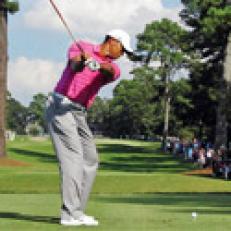BURNING INTO ATLANTA
My goal this year is to qualify for the Tour Championship [Sept. 23-26 at East Lake Golf Club in Atlanta]. I live in Atlanta, so playing in my town would be a big deal for me. I've been hitting the ball consistently, especially since the start of the summer. The reason? Just putting the time in on swing changes with my instructor, Chris O'Connell. Chris teaches Jim Hardy's one-plane swing method. We're getting my hips to move more efficiently and clear better. Now it feels as if my hands stay in tight to my body [a basic tenet of a one-plane swing], and then the club just whips around into the ball. This is a big reason I've been playing so well. I'm driving it straighter and giving myself more chances to make birdies.--Matt Kuchar
BIO: 32, 6-feet-4, 195 pounds | __DRIVER:__Bridgestone J38, 10 deg. | __BALL:__Bridgestone B330-S | DRIVING DISTANCE (RANK): 285.7 yards (105th) | DRIVING ACCURACY (RANK): 68 percent of fairways (28th)
BIO: 32, 6-feet-4, 195 pounds | __DRIVER:__Bridgestone J38, 10 deg. | __BALL:__Bridgestone B330-S | DRIVING DISTANCE (RANK): 285.7 yards (105th) | DRIVING ACCURACY (RANK): 68 percent of fairways (28th)
MAJOR RENOVATIONS
Kuchar's game is booming with the one-plane swingBack in 1998, when Matt Kuchar was smiling his way to finishing T-21 in the Masters and T-14 in the U.S. Open as an amateur, it seemed as if he was destined for golf stardom. Twelve years later, with only two tour wins in more than 210 events, Kuchar hasn't exactly lived up to those expectations, but he is finally starting to play world-class golf. After his victory at the Turning Stone Resort Championship late last year, he has had nine more top-10 finishes -- and in June jumped into the top 25 in the World Golf Ranking.An overhauled swing has made a big difference, according to his teacher, Chris O'Connell. "When I first met Matt, he would aim left of his target, turn his shoulders flat in the backswing, and then thrust his hips toward the target line," O'Connell says. "This inside-to-outside path, coupled with his aim, required him to block the ball toward the target. He also had a very shallow angle of attack and excessive clubface rotation through impact. He was way too reliant on timing, and he couldn't produce enough spin on middle- and long-iron shots."So they went to work on Kuchar's alignment (more to the right), backswing (steeper shoulder turn) and downswing (aggressive body turn through the ball). The final pieces are changing his hip thrust into a hip rotation and getting his hands and arms to stay closer to his body, so the clubface will be more stabilized during impact. If that sounds like a lot, it is, but it's starting to pay off.* -- Ron Kaspriske*
We're getting my hips to move more efficiently and clear better. Now it feels as if my hands stay in tight to my body [a basic tenet of a one-plane swing], and then the club just whips around into the ball.
Nice width off the ball. This sets up the correct angle coming down.
Matt's now doing a better job of making a full turn -- his upper body is well behind the ball.
Posting up on his left leg keeps the club on a good path into impact.
Classic one-planer: Left arm on the same angle as the shoulders.
Copy this move: The club is back on its original shaft plane and pointing at the ball.
His right foot is nearly flat. This means he didn't thrust his hips.
He maintained his spine angle and turned through nicely.
His arms swing low and inside; his shoulders turn steeply.
Copy this move: The club is back on its original shaft plane and pointing at the ball.
Notice how his arms and club start tracking back inside the target line just after impact.
















